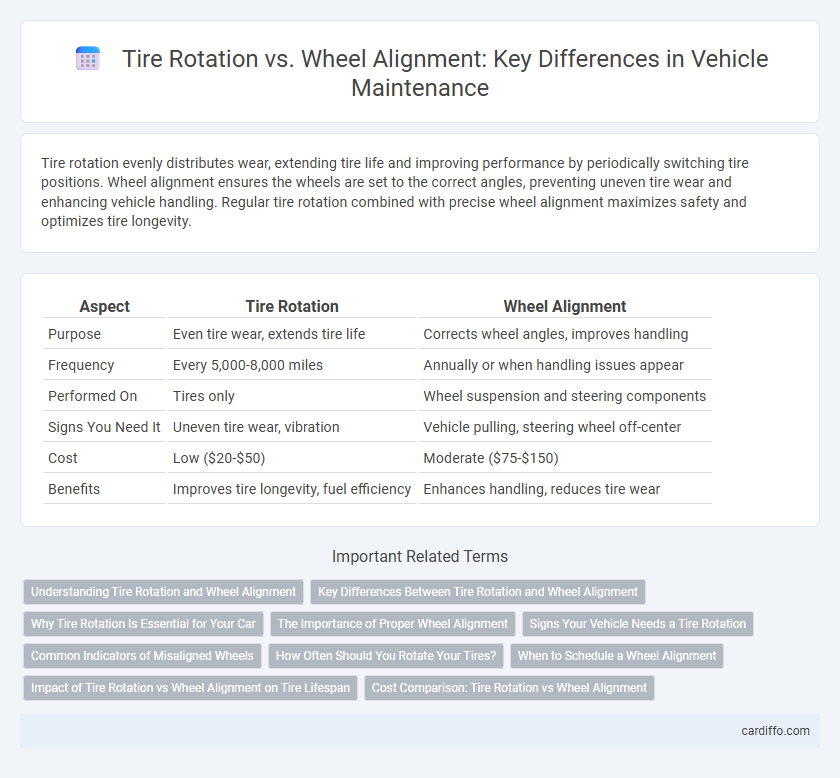Tire rotation evenly distributes wear, extending tire life and improving performance by periodically switching tire positions. Wheel alignment ensures the wheels are set to the correct angles, preventing uneven tire wear and enhancing vehicle handling. Regular tire rotation combined with precise wheel alignment maximizes safety and optimizes tire longevity.
Table of Comparison
| Aspect | Tire Rotation | Wheel Alignment |
|---|---|---|
| Purpose | Even tire wear, extends tire life | Corrects wheel angles, improves handling |
| Frequency | Every 5,000-8,000 miles | Annually or when handling issues appear |
| Performed On | Tires only | Wheel suspension and steering components |
| Signs You Need It | Uneven tire wear, vibration | Vehicle pulling, steering wheel off-center |
| Cost | Low ($20-$50) | Moderate ($75-$150) |
| Benefits | Improves tire longevity, fuel efficiency | Enhances handling, reduces tire wear |
Understanding Tire Rotation and Wheel Alignment
Tire rotation involves periodically changing the position of tires to ensure even wear and extend tire lifespan, typically every 5,000 to 8,000 miles. Wheel alignment adjusts the angles of the wheels to the manufacturer's specifications, preventing uneven tire wear and improving vehicle handling. Proper maintenance of both tire rotation and wheel alignment enhances safety, fuel efficiency, and overall driving performance.
Key Differences Between Tire Rotation and Wheel Alignment
Tire rotation involves periodically changing the position of each tire to promote even wear, extending tire life and improving vehicle handling. Wheel alignment adjusts the angles of the wheels to manufacturer specifications, ensuring proper tire contact with the road and preventing uneven wear or steering issues. Key differences include tire rotation's focus on wear distribution versus wheel alignment's emphasis on correcting wheel angle settings for optimal performance.
Why Tire Rotation Is Essential for Your Car
Tire rotation is essential for your car because it ensures even wear across all tires, prolonging their lifespan and enhancing vehicle safety. Regularly rotating tires helps maintain balanced handling and improves fuel efficiency by preventing uneven tread wear. Neglecting tire rotation can lead to premature tire replacement and compromised driving performance, making it a crucial maintenance practice.
The Importance of Proper Wheel Alignment
Proper wheel alignment ensures optimal tire contact with the road, which significantly improves vehicle handling, fuel efficiency, and tire lifespan. Misalignment can cause uneven tire wear, leading to premature tire replacement and increased maintenance costs. Regular alignment checks prevent suspension strain and enhance overall driving safety, making it a crucial aspect of vehicle maintenance.
Signs Your Vehicle Needs a Tire Rotation
Uneven tire wear, such as more tread wear on one edge or bald spots, signals the need for a tire rotation to extend tire lifespan and improve safety. Vibrations or unusual noises while driving can also indicate misaligned tires requiring rotation and inspection. Monitoring tread depth regularly ensures balanced wear and optimal traction, preventing costly repairs and enhancing vehicle handling.
Common Indicators of Misaligned Wheels
Uneven tire wear, such as excessive wear on one side of the tire, often signals misaligned wheels requiring immediate attention. Steering wheel vibration or pulling to one side during driving are critical indicators that the wheel alignment is off. Addressing these issues promptly through proper wheel alignment improves tire lifespan and vehicle safety, distinguishing it from routine tire rotation.
How Often Should You Rotate Your Tires?
Tire rotation is recommended every 5,000 to 7,500 miles to ensure even tire wear and extend tire lifespan, while wheel alignment should typically be checked once a year or when you notice uneven tire wear or vehicle pulling to one side. Rotating tires regularly maintains balanced traction and improves fuel efficiency by promoting uniform tread wear. Consult your vehicle's owner manual for specific rotation intervals based on tire type and driving conditions.
When to Schedule a Wheel Alignment
Schedule a wheel alignment when you notice uneven tire wear, the vehicle pulling to one side, or a crooked steering wheel while driving straight. Regular alignments, typically every 12,000 miles or once a year, help maintain optimal tire performance and extend tire lifespan. Proper wheel alignment improves fuel efficiency and ensures safe handling, especially after hitting curbs or potholes.
Impact of Tire Rotation vs Wheel Alignment on Tire Lifespan
Tire rotation evenly distributes wear by periodically changing the position of each tire, extending overall tire lifespan and improving performance. Wheel alignment ensures tires are set at the correct angles, preventing uneven tread wear and enhancing handling stability. Proper maintenance combining both practices significantly reduces premature tire replacement costs and optimizes safety on the road.
Cost Comparison: Tire Rotation vs Wheel Alignment
Tire rotation typically costs between $20 and $50, making it a relatively affordable maintenance task that extends tire life by ensuring even wear. Wheel alignment services generally range from $75 to $150, reflecting the more complex process of adjusting the angles of the wheels to manufacturer specifications, which improves handling and tire longevity. Choosing tire rotation regularly can minimize costly wheel alignment needs by preventing uneven tire wear.
Tire rotation vs wheel alignment Infographic

 cardiffo.com
cardiffo.com